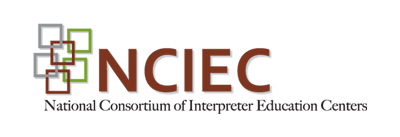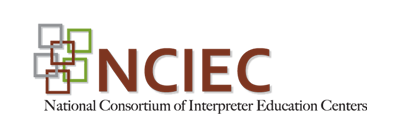VR: Faces of Deaf Consumers

Interpreting in VR Settings: Faces of Deaf Consumers
An infusion module for Interpreter Education Programs
Welcome to the National Interpreter Education Center (NIEC) classroom module, Faces of Deaf Vocational Rehabilitation Consumers. This resource is designed to expose interpreting education students to VR and to foster interest in working within this setting. The module contains information on the needs of consumers exclusively. Though a great deal of interpreting that occurs in VR settings includes Deaf professionals, this module does not address this unique population. The module was reviewed and updated in 2016 by the NIEC team. This module is designed to be integrated into your learning environment. All the content is available as PDFs that can be downloaded and inserted into your institution’s Learning Management System (LMS), such as Blackboard, Moodle, etc. We have also provided “doc” versions of the content that you may customize according to your needs as long as you follow the copyright language at the bottom of each page. All video content is provided with links that you can copy and paste into your LMS. We offer you this content free of charge and encourage you to incorporate it into your curriculum. We ask that you retain the citation information available on the downloaded documents. A comprehensive overview of the diversity of Deaf VR consumers is not possible in this module. Our intent is to provide a primer on some of the salient characteristics of these consumers. The focus of the module is on the unique communication needs of Deaf individuals, particularly those who may have limited language proficiency, and the impact of Deaf education on the communication of Deaf individuals. The module briefly addresses the challenge faced by Deaf individuals who may have a disability or are immigrants from countries that do not use ASL. The three main components of the module are an overview of the factors to consider when describing the identity and communication skills of Deaf individuals, an overview of the types of educational settings currently available in the US for Deaf children and the importance of an interpreter’s ability to self-assess his or her language and interpreting skills when contemplating accepting an interpreting assignment. Each of these components includes at least a short reading and a PowerPoint presentation synthesizing the reading and related activities. The mission of the National Consortium of Interpreter Education Centers (NCIEC) is to build and promote effective practices in the fields of interpreting and interpreter education. The NCIEC was formed as a vehicle for sharing knowledge, expertise, leadership, and fiscal resources among the member Centers and for establishing important partnerships with consumer, professional, and academic organizations and institutions. The involvement of consumers and vocational rehabilitation service providers in the development and implementation of all educational initiatives ensures that programming is grounded in the realities of everyday life. This classroom module on Interpreting in VR settings is one of the products of the 2010-2015 cycle. In an effort to better understand the nature of specialized competence that is needed in order to interpret within this setting, a work-team comprised of members of the National Consortium of Interpreter Education Centers (NCIEC) was formed. The members of this team were Anna Witter-Merithew, Team Leader and Director of the MARIE Center; Trudy Schafer, Project Coordinator for the NIEC; Lillian Garcia Peterkin, Outreach Specialist for the NIEC; Pauline Annarino, Director of the WRIEC; and Anna Davis, Project Coordinator for the Regional Interpreter Education Center at Northeastern University. This team worked diligently to develop content specifications for curriculum development and products to support this initiative. Sincere appreciation and gratitude is extended to all the other Directors and Principal Investigators who make up the NCIEC and administer one of the six (6) member Centers—Ms. Pauline Annarino (WRIEC), Dr. Cheryl Davis (WRIEC), Ms. Cathy Cogen (NIEC), Dr. Dennis Cokely (NIEC), Ms. Diana Doucette (NURIEC), Ms. Bev Hollrah (GURIEC), Mr. Richard Laurion (CATIE), Dr. Laurie Swabey (CATIE), Ms. Anna Witter-Merithew (MARIE) and Dr. Leilani Johnson (MARIE). Without their leadership and fiscal support, this project would have been impossible. Mr. Doug Bowen-Bailey of Digiterp Communications co-constructed this module and shared his technical expertise unstintingly as the content took shape. We are grateful for his contribution. Copyright © 2013-2015 by the National Consortium of Interpreter Education Centers (NCIEC). This NCIEC product was developed by the National Interpreter Education Center (NIEC) at Northeastern University. Permission is granted to copy and disseminate these materials, in whole or in part, for educational, non-commercial purposes, provided that NCIEC is credited as the source and referenced appropriately on any such copies. The purpose of this module is to provide interpreting students with a brief introduction to vocational rehabilitation consumers who are Deaf. This module focuses on increasing an interpreter’s knowledge and understanding of the diversity of VR consumers, as well as some unique considerations when interpreting for these individuals. This module addresses the competencies relating to the skills and knowledge necessary to effectively interpret in VR settings. This module is introductory and will provide a foundation for additional study that will be required to become a competent interpreter in VR settings. By the end of this module, students will be able to: Copyright © 2013-2016 by the National Consortium of Interpreter Education Centers (NCIEC). This NCIEC product was developed by the National Interpreter Education Center (NIEC) at Northeastern University. Permission is granted to copy and disseminate these materials, in whole or in part, for educational, non-commercial purposes, provided that NCIEC is credited as the source and referenced appropriately on any such copies.Welcome
Intended use of Module
Overview of Module
VR: Faces of Deaf Consumers-Acknowledgements
Purpose:
Objectives:
